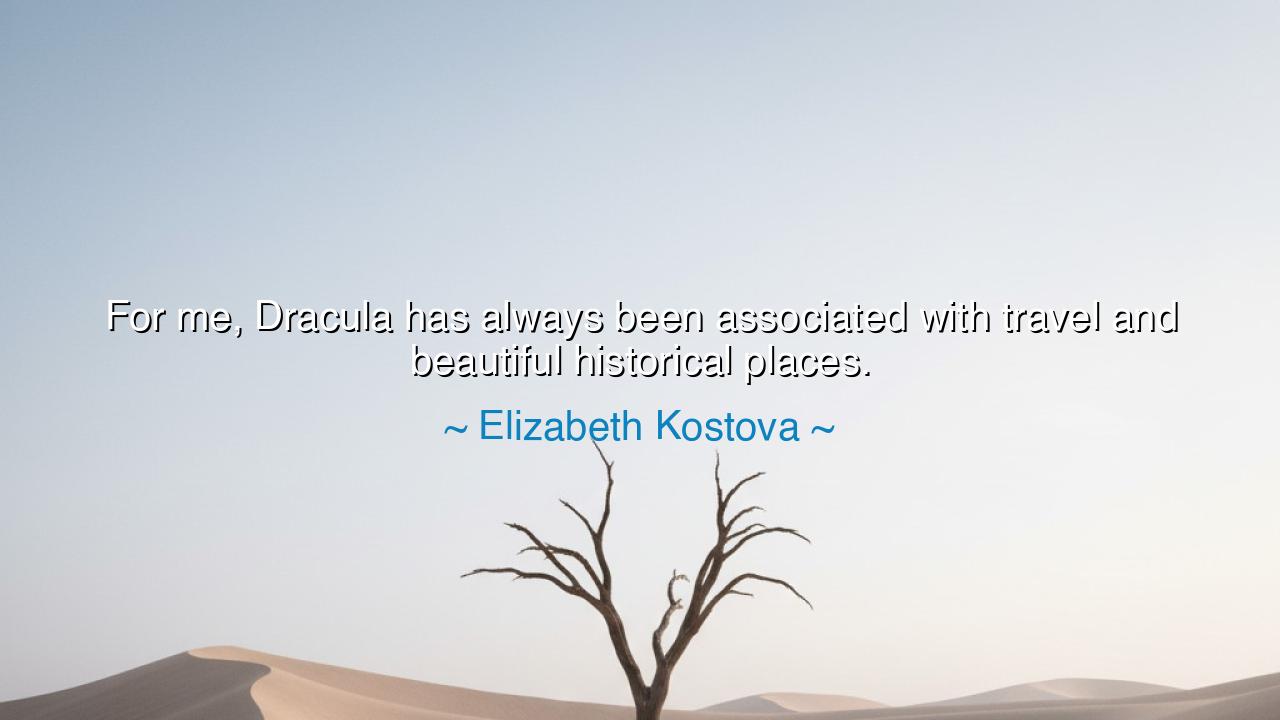
For me, Dracula has always been associated with travel and
For me, Dracula has always been associated with travel and beautiful historical places.






The words of Elizabeth Kostova — “For me, Dracula has always been associated with travel and beautiful historical places.” — carry a meaning deeper than they first appear. Though she speaks of a figure wrapped in myth and shadow, what shines through is the truth that stories live not only in the imagination, but in the landscapes of the earth. The legend of Dracula, rooted in Transylvanian castles, Carpathian forests, and medieval towns, is more than a tale of horror — it is a journey through time, where the traveler finds the past alive in stone, in mountain, in ruined fortress. In this way, the myth becomes inseparable from the act of travel, and the terror entwines itself with beauty.
From the beginning of storytelling, place has always given power to myth. The Greeks spoke of gods dwelling upon Mount Olympus, not in some distant heaven, but in a mountain they could see on their horizon. The Egyptians built their pyramids not only as tombs, but as eternal symbols binding their myths to the desert sky. So too, Dracula dwells not in some abstract darkness, but in castles perched on cliffs, in villages whispering of old rulers, in the mists of Eastern Europe where history and folklore breathe together. Thus, when Kostova speaks of beautiful historical places, she reveals that to walk the land is to walk within the story itself.
Consider the figure of Vlad the Impaler, the prince whose brutal reign gave shape to the Dracula legend. His life was real, set in the fifteenth century, in the borderlands of Europe’s great struggles. The fortresses he built, the towns he ruled, the mountains he defended — they remain standing, mute witnesses to both history and myth. To travel these lands is not simply to see relics; it is to feel the living pulse of human fear and heroism, cruelty and endurance, woven into their stones. Kostova’s words remind us that myth cannot be separated from the geography that cradled it.
There is also a deeper wisdom here: that every journey into foreign lands is also a journey into story. When we stand before ruins, when we walk through ancient streets, we enter the presence of all who have walked there before us. We feel their whispers, their victories, their tragedies. To see historical places is to be drawn into the epic tale of humankind, where each stone and shadow becomes a page. The legend of Dracula is only one such tale, but it teaches us that the world itself is a book, and the traveler its reader.
And yet, Kostova hints at something more — the blending of terror with beauty, of shadow with light. How strange that the monstrous figure of Dracula should be linked with lands of breathtaking beauty! But is this not the truth of all history? That the most wondrous places are often born of blood and sorrow, that every cathedral stands upon the graves of countless hands, that beauty and darkness are forever entwined? To see the castles of Transylvania is to see not only their majesty, but the cruelty and fear that gave them shape. This duality is what makes travel sacred: it reveals both the glory and the burden of the human story.
The lesson for future generations is clear: when you travel, do not see with the eyes of a tourist alone, but with the eyes of a seeker. Look not only at the surface beauty of places, but listen to the history they hold, however dark or unsettling. For true wisdom comes from embracing both the light and the shadow of human legacy. To know a place deeply is to know both its legends and its truths, both its myths and its blood.
In practice, let each traveler honor the lands they visit. Walk with reverence, learn the stories of the people, and let the myths guide you deeper into the meaning of what you see. Do not shy away from the darker tales, for they too reveal the resilience of the human spirit. Carry those lessons home, so that your journeys are not merely of sight, but of soul.
Thus, Kostova’s words stand as a reminder: Dracula is not only a monster of fiction, but a bridge between travel and history, between terror and beauty, between myth and memory. Every land has its own Dracula, its own legend rooted in its soil. To seek these stories is to awaken the spirit of the traveler, to find not only places, but the living heartbeat of humanity itself.






AAdministratorAdministrator
Welcome, honored guests. Please leave a comment, we will respond soon